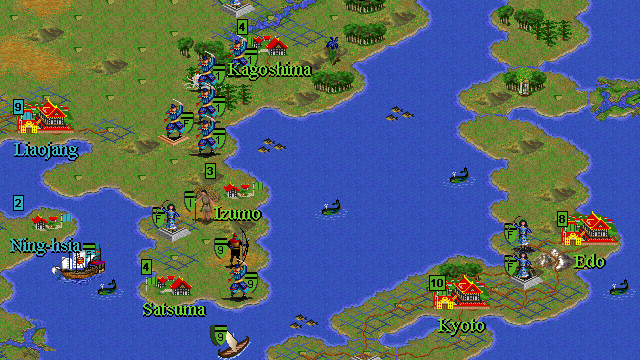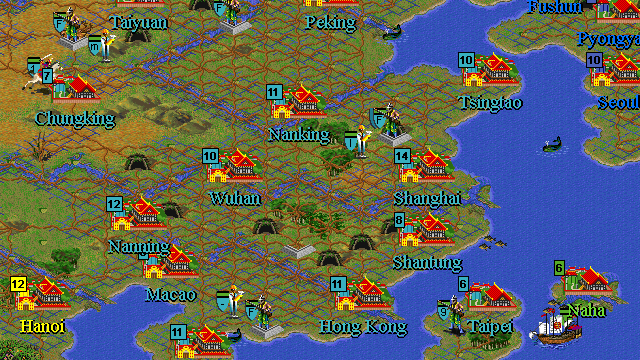History of Asia - Part A: Difference between revisions
(Created page with "Category:Patine Category:Ancient Ages Category:Civilization II: Multiplayer Gold Edition '''A scenario for Civilization II: Multiplayer Gold Edition by Patine...") |
mNo edit summary |
||
| Line 2: | Line 2: | ||
[[Category:Ancient Ages]] | [[Category:Ancient Ages]] | ||
[[Category:Civilization II: Multiplayer Gold Edition]] | [[Category:Civilization II: Multiplayer Gold Edition]] | ||
''' | '''Scenarios for [[Civilization II: Multiplayer Gold Edition]] by [[Patine]].''' | ||
Latest revision as of 07:02, 21 August 2012
Scenarios for Civilization II: Multiplayer Gold Edition by Patine.
Description
This pack contains four scenarios that detail the history of East Asia and the Pacific from 221 B.C., when Qin Shihuangdi proclaimed the Chinese Empire, till the First World War in the area. However, it notably excludes the era of Mongol expansion, which forms a gap between the first and second scenarios, and the high feudal era of Japan, which doesn't appear in the second scenario.
First Scenario (221 BC - AD 1209)
In the year 221 BC, Ch'in Shih Huang-ti united the fractured Chinese nation, drove out invaders from the North, and overthrew the ineffectual and complacent Chou Dynasty, forming the Chinese Empire, under his new Ch'in Dynasty, which he declared would begin 10,000 years of prosperity in the Middle Kingdom (so called as he believed China stood between Earth and Heaven). This is where our scenario begins. You may play the Chinese, the largest and most advanced civilization, or try something more challenging by playing another nation in East Asia and the Pacific at the time. There are the Japanese, united by the Yamato Clan (the later Imperial Family) after years of clan warfare, and now a strict military state, but still reasonably advanced. The Khmer, in Southeast Asia, are quite advanced and know much of building structures. The Indians are currently organizing into their caste-based, Hindu society in the country's North, though much of Southern India remains unsettled and wild. Even more challenging are the Australian Aborigines, Polynesians, and Indonesians, all of whom are very primitive and separated from each other and the mainland by sea, though the Polynesians have the easiest time seafaring. Each civilization has unique units in infantry and cavalry, and the Polynesians have a unique ship while the Japanese can gain the ninja assassin and spy. The scenario ends in AD 1209, when Temujin unites the Mongol hordes and ravages much of Asia.
Second Scenario (1368 - 1698)
It is the Year 1368, and the Mongol Empire has fractured into warring nations. The Chinese part, including the Mongol homeland, has come under the rule of the strict, xenophobic Ming Dynasty, which holds firm control and is very wealthy and powerful. In India and Central Asia, however, the Moslems who once lived under the Khans have revitalized Mongol rule fused with Islamic and Indian tradition to form the Moghul Empire. Southeast Asia, barely touched by the hordes, is now flourishing, whereas Indonesia has come under the control of the Chinese Admiral Zeng He and been reorganized as a united state. The Australian Aborigines and Polynesians, while isolated and primitive, have expanded considerably. And, finally, the Europeans, inspired by Marco Polo's tales of Cathay, are encroaching into Asia and the Pacific, having already annexed the primitive peoples of the Philippines, along with Russia, just broken free of the Golden Horde and moving into Siberia. You can play any one of these seven factions to decide the fate of Asia and the Pacific in the colonial era. Note that the Japanese are not present in this scenario, as they are in splendid isolation, riven by internal wars between warlords over the title of Shogun, and they kill all foreigners who trespass on their territory.
Third Scenario (1699 - 1913)
In 1644, the decadent and crumbling Ming Dynasty of China has been replaced with the new Ching Dynasty established by the neighboring Manchus after a successful invasion. This new regime is friendlier to European interests and thus has freely opened commerce with foreigners. Meanwhile, Tokugawa Yoshimune, the Shogun of Japan, has also opened relations with the West, though Japan is still quite anachronistic. Korea has reorganized into a new military state with stunning new naval technology that stands against both the Chinese and Japanese. The Siamese and other Southeast Asians are currently thriving, but risk annexation by the Europeans. The old Moghul Empire and Indonesians are both divided between European colonies and independent (Barbarian) cities. The Europeans also control most of the Pacific islands and have colonies on Australia, where Aborigines (again Barbarians) still hold most of the land. The Russians are expanding rapidly East and already have a Pacific port. And, the Hawaiians, who hold the only free Pacific islands, have built a thriving kingdom. You may play any one of these seven factions just before the turn of the 18th Century until the Great War begins, playing a part to decide the fate of Asia and the Pacific.
Fourth Scenario (1914 - 1920)
War has erupted in Europe between the Great Powers, and this conflict threatens to extend to European holdings in East Asia and the Pacific. The Germans (the only of the Central Powers represented on the map, as Austria-Hungary and Bulgaria have no holdings outside Europe, and the Ottoman Empire doesn't extend that far east) holds part of New Guinea, most of the Solomon Islands and Micronesia, part of Samoa, and a colony in East China, and they're the protagonist, so it's an uphill battle for them. The Russians and the Franco-British (the French and British are one faction in this scenario) are the principal European Allies in the region, with the Russians holding Siberia and the Franco-British holding India, Ceylon, Burma, French Indo-China, Macao and Portuguese Timor (technically Portuguese holdings, but counted under this player as Portugal was very close to Britain), Hong Kong, Malaysia, Papua New Guinea, Australia, New Zealand, Fiji, the Mariana, Marshall, Ellige, and New Hebrides Islands, French Polynesia, part of Samoa, and Western Canada. The Japanese and Chinese are on the Allied side, though the Japanese and Russians and the Chinese and Japanese both have bad blood from recent conflicts, and thus the Franco-British must hold the alliance together. One shouldn't play the Siamese, who are small and backward, or the Americans and Neutrals (who include not only the Western U.S., but the American holdings of Alaska, Hawaii, Guam, and the Philippines, the Dutch East Indies (for the Netherlands) and Nepal, as they weren't involved in this conflict (though the Americans later joined the European Campaigns). The Germans must seize as many nearby Allied colonies as possible to win; the Allies must prevent it.
Screenshots
Downloads
Scenario Files (246 kB)
Sound Files (1.16 MB)

